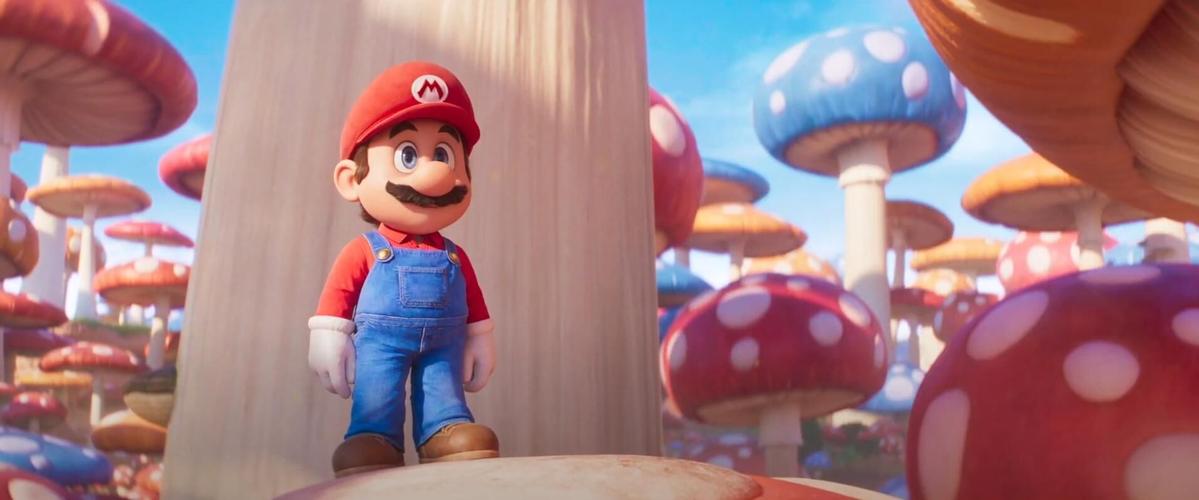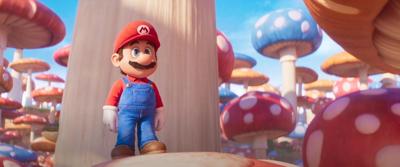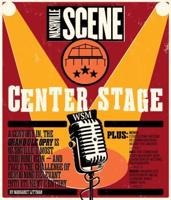The Super Mario Bros. Movie
Thirty years after a semi-visionary studio-recut mess that left audiences bewildered, Nintendo’s pride and joy have returned to the big screen in a colorful and vibrant animated endeavor (made in conjunction with Illumination, the studio behind the Minionsverse). The Super Mario Bros. Movie is, in many ways, a branding recommitment that above all else erases the 1993 Jankel and Brooks film and reestablishes our dudes Mario (Chris Pratt, who does not draw attention to himself) and Luigi (Charlie Day, who isn’t given nearly enough) as hapless plumbers with hearts of gold. The two get swept into another dimension wherein they must stop a rampaging superturtle from Sheriff-of-Nottinghaming his way into a marriage with a pastel-clad sovereign (Anya Taylor-Joy, whose deadpan Princess Peach does quite a bit of heavy lifting).
About that superturtle ... Bowser, voiced by Jack Black (having more fun than everyone else in the whole endeavor), is a megalomaniac nonetheless plagued by deep insecurity. He’ll gleefully torch an ice castle and subjugate countless beings to his will, but also have introspective piano moments while overthinking every interaction he might have with someone he hasn’t even met in person yet. Black’s Bowser is the apotheosis of Leo energy, and the actor is now officially forgiven for I Still Know What You Did Last Summer.
Super Mario Bros. is not a sacred text, and this is a movie made for kids, stoners and the gaming and DeviantArt communities. It’s a visual treat (I’m seeing the damn thing again just for the 3D experience, because this is tailor-made for such a thing), and it is packed full of dad jokes (including the most jaw-dropping ongoing Vietnam joke you could ever expect in a children’s film) and an overwhelming amount of Easter eggs for fans of the game. If they make a sequel, I’d love for it to be a left-field remix of Yume Kōjō: Doki Doki Panic. Let Birdo claim their flowers as a trans icon. Let the land itself yield vegetables to be hurled at one’s enemies.
Country Gold
Writer-director (and in this case, star) Mickey Reece has been one of the most interesting voices in American indie cinema for several years now, leaping between genres and tones with the kind of gonzo nimbleness that it took directors like Steven Soderbergh and Spike Lee more than a decade working in and adjacent to the big studio system to be able to access. And while his microbudget affairs have been the talk of the festival circuit, the Oklahoma City auteur has tragically never gotten the sort of mainstream traction that could be a leg up in awareness beyond the freaks, critics and cinephiles who soak in the wild and the weird.
Hopefully that changes now. With Country Gold, Reece has taken an idiom he worked in masterfully with 2017’s Mickey Reece’s Alien — a stylized black-and-white “what if” about the life of Elvis Presley — and crafted a Nastyville Brundlefly of This Is Spinal Tap and Once Upon a Time in Hollywood made in deep affection to the giants of country (and their many foibles).
In 1994, Troyal Brux (Reece, the exact kind of amiable egotist for the part) is on the rise, navigating the precipice of fame with the anchors of family and perspective. But he’s shaken when he gets a letter from the legendary George Jones (Ben Hall) inviting him out to Nashville for the weekend, and he leaps at the chance to talk and hang out with a living icon. But what he finds there is nothing like what he expected, with The Possum looking to spend a night on the town before going in for cryogenic freeze the next morning.
Country Gold is a weird, oddly moving film about fame, integrity and the origins of our capacities for reinvention. It is vulgar, occasionally silly and ultimately deeply effective, and its genuine affection for (and perceptive needling of) these personae will hopefully give it the immortality it rightfully deserves. May it be shared among musicians, speed freaks, comedy heads and whatever passes for record label boardrooms these days. There’s nothing that captures the timeless idea of Nashville quite like the brief montage we see from Troyal’s eyes, artfully composed pointillist pieces of the more timeless parts of the city, shot sometime in the pandemic era but still full of ghosts; victims of the city’s consumptive desire to remake and remodel, never to erase and rewind.

Dungeons & Dragons: Honor Among Thieves
Dungeons & Dragons: Honor Among Thieves
The unspoken truth about post-Star Wars Hollywood filmmaking is that oftentimes, casting a blockbuster really is like assembling a Dungeons & Dragons campaign. You’ve got to balance your appeal across all audience quadrants, allocating your resources to assemble the team that’s going to accomplish your mission — whether that’s breaking box office records or avenging the tragic collateral damage in the ongoing war between sundry clans of thieves, sorcerers, highwaymen, shapeshifters and all manner of creatures.
The pleasure of a D&D adventure, both the game and in this rather enjoyable film take on the material, is the way the lore can feel both carved in stone on ancient peaks but also quickly improvised for a maximum dose of drama. The script (by Chris McKay, Michael Gilio and directors John Francis Daley and Jonathan Goldstein) draws gleefully from all manner of fantasy traditions, giving us the kind of loose gathering of archetypes that allows all participants to feel part of the proceedings. My old D&D group had rugby players and porn stars (I was a social justice illithid), and that was before anyone rolled a die.
Maximum respect to Michelle Rodriguez as Holga the Barbarian (is that a sly Flannery O’Connor reference?), Sophia Lillis as Doric the Wild Shape Druid (who is just as cool as a battling Owl-Bear as she was as Nancy Drew) and Regé-Jean Page as the smoove paladin Xenk. Chris Pine is good as our ostensible lead Edgin, but he’s a bard (in one of the great jokes that IRL players will most appreciate). Also, Arrested Development made a joke of the “he’s just trying to get his kids back” trope decades ago, and it feels like a disservice both to him and to the character of his daughter.
As with the Super Mario film, there are so many Easter eggs here that it can feel overwhelming at times. But this film understands the unspoken beauty of playing the game — sometimes you have to pee real bad, or the exterior world intrudes and you have to put out a fire real quick. The game (and the film) isn’t depending on just you; it’s a demonstration of the collective in action, and it’s ready for you when you can duck back in. And you absolutely should — there’s so much imagination in the film’s dungeons and its dragons, and when the magic starts happening and we tip into the fray, it’s fun. Unlike so many of the big effects-based action/superhero films, this one is kinda breezy and a lot of fun. A special shout-out to the continuous sequence in which Doric shifts through several forms during an escape fight, getting into the possibilities that dramatically rendered Wild Shape can offer to the viewer.
Renfield
A tonal jumble that at times feels like a Godfrey Ho film but that proves beyond a shadow of a doubt that Nicholas Hoult is an absolute treasure, Renfield is a deeply odd film. Positioning itself as the further adventures of good ol’ Count Dracula (Nicolas Cage, uncaged) and his manservant Robert Montague Renfield (Hoult, who makes disheveled, floppy hair into a looming trend), this finds the duo holed up in an abandoned New Orleans hospital while the Count regains his unholy power. Marvelous detail — Dracula’s throne has empty blood bags arrayed behind it like peacock feathers, one of several touches that from the ground up help us to metabolize Renfield’s diminished sense of self and agency.
There’s a sincere attempt to graft Stoker’s characters onto a reflective/self-help narrative (think how Alien3 did so with Kübler-Ross’s Questions on Death and Dying), and it’s on a dialectical collision course with a grungy, gory story of Dracula and the ethnically nonspecific Mob. In all honesty, horror, action, comedy and self-help all get mushed up together with seemingly no regard for linear progression, which is occasionally exciting but consistently jarring, like there are four different cuts of the film and some executive has had one too many and is zapping between quadrants all willy-nilly.
Hoult and Cage are both good, and Awkwafina is given a Mad Libs of a cop character that she does what she can with. I’m always happy to see a great actress in a trashy movie in an elegant pantsuit, and Shohreh Agdashloo simply presides — Cage gets to wear the most intricate effects makeup and prosthetics, but Agdashloo gets the best outfits as the head of New Orleans’ most feared crime family.
It’s hard to say whether it’s just being worn down as a viewer over time or a shift in characterization motivated by a later plot point, but the artist formerly known as Jean-Ralphio starts out like he’s gunning for William Forsythe in Halloween 2007’s crown as worst performance in a horror film, thankfully taking a different turn in the home stretch. (A major plus: 93 minutes long.) This is not a good film, but it is exactly the kind of fitfully amusing and insanely gory film that sticks in the craw — and that you remember with just enough affection that you greet it like an old college acquaintance instead of a green-light-laden waste of time. (Jim Ridley was like that with John Carpenter’s Ghosts of Mars.)







